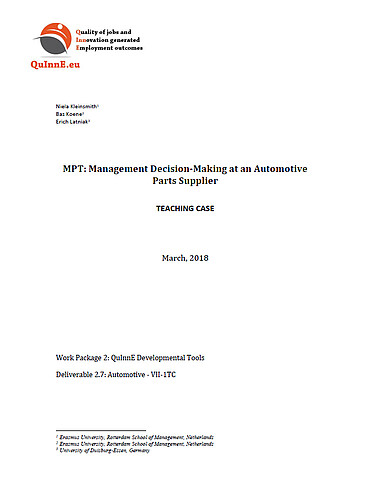Citation Note
Based on field research; 14 pages.
Follow the 'handle' link to access the Case Study on RePub.
For EUR staff members: the Teaching Note is available on request, you can contact us at rsm.nl/cdc/contact/
For external users: follow the link to purchase the Case Study and the Teaching Note.
Abstract
In October, 2017, Henry Novak, Plant Manager for MPT (Moulded Plastic Technologies), a mid-sized, family-owned, European automotive supplier, walked across the shop floor during his regular 'caravan' morning tour with his senior team. Since the global financial crisis, when MPT's family-owners had appointed a new general manager, the company had undergone major restructuring and was slowly making a comeback from the brink of bankruptcy. But with the disruptive changes occurring in the automotive industry, MPT still had a long way to go to secure its future. In particular, executive management was trying to resolve two divisive issues: (1) should the company make substantial investments in more automated production equipment; and (2) how could the company better respond to RFQs from OEMs , as response times and details were often insufficient? Walking around the shop floor, Novak had the answers to both of these questions, and was looking forward to the management meeting later in the day to present his arguments.
Objective
1. Describe the key groups of players and trends in the automotive industry. 2. Explain the Kaizen production philosophy and how it can be implemented in a manufacturing facility. 3. Evaluate some advantages and disadvantages of automation in manufacturing, based on the impact of various production requirements. 4. Decide on the best approach for this automotive supplier to respond to OEM RFQs in a timely and thorough manner.
